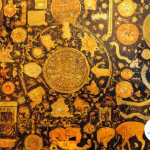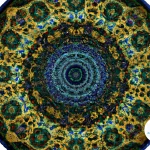Understanding the Importance of Planetary Aspects in Astrology – Unlocking the Mysteries of the Stars and their Influence
The realm of astrology has captivated human imagination for centuries, offering insights into our personalities, relationships, and life paths. At the heart of this ancient practice lie planetary aspects, the celestial dance of the planets that creates a unique energy and influence on our lives. From conjunctions to trines, squares to sextiles, these planetary alignments hold the key to understanding the intricate web of our existence. In this comprehensive guide, we delve into the significance of major and minor planetary aspects, explore their interpretation, and uncover how they shape our personality traits, relationships, and career paths. So, fasten your seatbelts and prepare to embark on a cosmic journey that will broaden your horizons and deepen your understanding of the intricate tapestry of the universe.
What are Planetary Aspects?

Planetary aspects refer to the angles formed between two or more planets in an astrological chart, indicating the energetic interaction between them. These aspects reveal the dynamic relationships and connections between different celestial bodies, and they play a crucial role in shaping the overall astrological interpretation. Understanding the significance of planetary aspects allows astrologers and enthusiasts to gain deeper insights into various aspects of a person’s life, such as their personality traits, relationships, and career path. The aspects can be categorized into major and minor aspects, each carrying its own unique energy and influence. Major aspects include conjunctions, oppositions, trines, squares, sextiles, quincunxes, and semi-sextiles, while minor aspects include semi-squares, sesquiquadrates, quintiles, and biquintiles. Each aspect has its own distinct qualities and impact on the individual’s chart. So, whether you’re examining a birth chart to understand yourself or diving into the significance of aspects for your weekly horoscope, delving into the world of planetary aspects is a fascinating journey of self-discovery and cosmic exploration.
Major Planetary Aspects
Major planetary aspects are the key angles formed between two or more planets in astrology that carry significant meaning and influence. These aspects have a profound impact on an individual’s chart and can reveal important dynamics and themes in their life. Let’s explore some of the major planetary aspects:
1. Conjunct: A conjunction occurs when two planets are in close proximity to one another, creating a powerful fusion of their energies. This aspect signifies a harmonious blend or intense focus of the planets involved.
2. Opposition: An opposition happens when two planets are directly across from each other in the chart, forming a 180-degree angle. This aspect represents a polarity or tension between the energies of the planets involved.
3. Trine: A trine occurs when two planets are approximately 120 degrees apart, forming a harmonious and flowing connection. This aspect signifies ease, cooperation, and favorable interactions between the planets.
4. Square: A square is formed when two planets are approximately 90 degrees apart, creating a challenging and dynamic aspect. This aspect represents tension, obstacles, and opportunities for growth and transformation.
5. Sextile: A sextile occurs when two planets are approximately 60 degrees apart, forming a positive and supportive connection. This aspect represents opportunities, ease, and favorable circumstances for growth and development.
6. Quincunx: A quincunx is an aspect where two planets are approximately 150 degrees apart, creating a subtle and complex interaction. This aspect signifies a need for adjustment, adaptation, and finding a balance between the energies involved.
7. Semi-Sextile: A semi-sextile happens when two planets are approximately 30 degrees apart, forming a minor and supportive aspect. This aspect represents opportunities for integration and cooperation between the planets.
Understanding the major planetary aspects allows astrologers and enthusiasts to interpret the complex interplay between celestial bodies and gain deeper insights into a person’s chart. Whether you’re exploring the significance of aspects in your weekly horoscope or delving into the mysteries of astrology, these major aspects hold valuable clues to understanding the intricate tapestry of the universe.
1. Conjunct
The conjunct aspect, denoted by the symbol (☌), occurs when two planets are close to each other in the same zodiac sign, creating a powerful fusion of their energies. It is one of the most potent and impactful planetary aspects in astrology. When planets are conjunct, their energies blend and intensify, creating a concentrated force that significantly influences the individual’s personality and life experiences. This aspect signifies a strong connection and alignment between the planets involved, amplifying their combined effects. The specific qualities of the planets involved in the conjunction determine the overall impact. For example, the conjunction of Mars and Venus can bring forth intense passion and creativity, while the conjunction of Mercury and Neptune may enhance intuitive and imaginative abilities. The conjunct aspect can have both positive and challenging effects, depending on the planets and signs involved. It is essential to consider the overall context of the birth chart to fully comprehend the implications of a conjunction. When examining the significance of the conjunct aspect in astrology, it can be an excellent indicator for understanding compatibility in relationships, as well as an essential factor in creating accurate weekly horoscopes. Understanding the intricacies of the conjunct aspect allows astrologers and enthusiasts to gain deeper insights into the multifaceted nature of human existence and the influences of the planets on our lives.
2. Opposition
The opposition is one of the major planetary aspects that holds significant meaning in astrology. It occurs when two planets are approximately 180 degrees apart, creating a dynamic tension between their energies. This aspect represents a polarizing force, where the two planets involved are in opposite signs and often opposing elements. The opposition aspect brings about a sense of duality and conflict, highlighting the need for balance and integration in the areas of life represented by the planets involved.
In an opposition, the energies of the planets involved may seem contradictory or at odds with each other. However, this aspect also offers an opportunity for growth and understanding. It acts as a mirror, reflecting back to us the aspects of ourselves that we need to reconcile and find harmony within. For example, a Sun-Moon opposition may symbolize a clash between our conscious ego and our emotional needs, indicating a need to find a balance between these two forces.
The opposition aspect often pushes us out of our comfort zones and challenges us to find a middle ground or seek compromise. It can bring about tension, but also a deep sense of awareness and personal growth. By embracing its lessons, we can navigate the complexities of life and relationships with greater wisdom and understanding.
In terms of interpretation, the houses that the planets occupy will provide insights into the specific areas of life where this tension and balance-seeking is playing out. The signs involved in the opposition will also add nuances to the interpretation, offering clues about the qualities and themes at play.
Understanding the significance of the opposition aspect is essential for astrologers and enthusiasts alike. Whether you’re exploring the significance of oppositions in your weekly horoscope or studying the daily influences of opposing planets in the houses of your birth chart, recognizing the dynamics of this aspect provides valuable insight into the complexities of human experience and personal growth. By acknowledging and embracing the challenges that the opposition brings, we can navigate its energies with grace and harness its transformative potential.
3. Trine
A trine is a harmonious and beneficial aspect in astrology. It is formed when two planets are approximately 120 degrees apart in the astrological chart. This aspect represents a flow of positive energy and easy communication between the planets involved. When two planets are in a trine, they work together harmoniously, promoting growth, creativity, and opportunity in the areas of life they influence. The trine aspect signifies a natural synergy and alignment, enabling the planets to support and amplify each other’s qualities. It often brings favorable circumstances, blessings, and a sense of ease in navigating through life’s challenges. For example, if Venus and Jupiter form a trine in a birth chart, it indicates a harmonious blend of love, abundance, and good fortune. It suggests that these areas of life will come easily to the individual and bring positive experiences. Trines provide an opportunity for personal growth and can be seen as a gift from the universe. Understanding the significance of trines can greatly enhance astrological interpretations, whether you’re exploring their role in weekly horoscopes, delving into the influences of different houses in daily horoscopes, or examining the third house in astrology to uncover communication patterns and intellectual pursuits. So, embrace the cosmic harmony and harness the power of trines to manifest your dreams and embrace the abundance life has to offer.
4. Square
A square is a major planetary aspect that occurs when two planets are approximately 90 degrees apart in the astrological chart. This dynamic angle creates tension and challenges, often leading to significant growth and transformation. Symbolically, a square represents a clash or conflict between the energies of the involved planets, resulting in a push-pull effect. It signifies the need for action and resolution, as well as the potential for inner strength and personal development. When a square aspect is present in a birth chart or a transit, it can signify areas of life where obstacles and difficulties may arise. However, it’s important to remember that squares also offer opportunities for growth and learning. They push us to confront our limitations, make necessary changes, and ultimately, evolve as individuals. For example, if Mars squares Saturn in a birth chart, it may indicate challenges in asserting oneself and pursuing goals. However, with conscious awareness and effort, individuals with this aspect can develop resilience, discipline, and strategic planning skills to overcome obstacles. Understanding the significance of squares is essential in interpreting astrological aspects accurately and gaining insights into our strengths, weaknesses, and life lessons. So, whether you’re exploring the significance of aspects in your weekly horoscope or delving deeper into the astrological houses in your daily horoscopes, embracing the transformative energy of squares can lead to personal growth and empowerment.
5. Sextile
The sextile is a harmonious aspect in astrology that occurs when two planets are approximately 60 degrees apart in the astrological chart. This aspect creates a positive and supportive connection between the planets involved, allowing them to work together in a balanced and complementary manner. The sextile represents opportunities, creativity, and ease of communication between the planets. It is often seen as a gentle push or a helping hand from the universe, offering a favorable alignment that can facilitate growth and progress. The sextile encourages the planets to exchange energy and collaborate, enhancing their individual potentials. It brings forth a sense of possibility, encouraging us to explore new avenues and embrace the potential that arises. In a birth chart, a sextile can indicate areas of natural talent and ease, where the individual has a knack for bringing together the qualities represented by the planets involved. For example, a sextile between Venus and Mars can signify a harmonious blend of love and passion, creating an individual who expresses their desires with grace and confidence. When interpreting a sextile, it is important to consider the signs and houses involved, as they provide additional layers of meaning and context. Whether you are seeking to understand the significance of the sextile in your weekly horoscope or exploring the intricate dynamics of different astrological houses, understanding this aspect adds depth and insight to your astrological journey. So, embrace the positive energy of the sextile and allow it to guide you towards greater harmony and alignment in your life.
6. Quincunx
A quincunx is a minor planetary aspect that occurs when two planets are approximately 150 degrees apart. It is also known as an inconjunct aspect. The quincunx creates a challenging energy that requires adjustment and adaptation in order to find balance. This aspect brings together two planets that have nothing in common, creating a sense of unease and tension. It can be likened to two puzzle pieces that don’t quite fit together, requiring effort and creativity to make them align. The quincunx often represents areas of life where there is a need for growth and transformation. It may indicate a conflict or disconnect between different aspects of our lives, requiring us to make adjustments and seek alternative approaches. For example, in a birth chart, a quincunx between the Moon and Mercury could suggest a struggle between our emotions and communication style. This aspect may require us to find ways to express ourselves more effectively while also navigating our emotional sensitivities. Understanding the influence of the quincunx is valuable for astrologers and individuals alike, as it offers insights into areas where challenges may arise and encourages a willingness to adapt and find innovative solutions. So when exploring the significance of aspects, such as the quincunx, in your weekly horoscope or delving into the complexities of the houses in astrology, remember that these aspects are opportunities for growth and self-discovery. Let the quincunx guide you towards finding harmony and balance in all areas of your life.
7. Semi-Sextile
The semi-sextile aspect is a minor aspect in astrology, indicating a subtle and harmonious connection between two planets that are approximately 30 degrees apart. It brings a sense of cooperation and collaboration between the energies represented by the planets involved. This aspect encourages communication and understanding, fostering a sense of balance and compromise. The semi-sextile aspect is often associated with opportunities for personal growth and development, as it encourages us to integrate different aspects of our lives. It prompts us to find harmony between seemingly opposing forces, allowing us to navigate challenges with ease and grace. While the semi-sextile aspect may not be as intense or transformative as some of the major aspects, its influence should not be underestimated. It adds nuance and depth to the overall astrological interpretation, providing valuable insights into how different planets interact within an individual’s chart. So, whether you’re exploring the significance of aspects for your weekly horoscope or delving into the fascinating world of astrology to understand the daily influences of the planets, the semi-sextile aspect offers a subtle yet impactful connection that adds richness to our lives.
Minor Planetary Aspects

Minor planetary aspects, as the name suggests, are the less prominent angles formed between planets in an astrological chart. While major aspects hold significant influence, minor aspects provide additional nuances and subtleties to the interpretation. These aspects include the semi-square, sesquiquadrate, quintile, and biquintile. The semi-square, a 45-degree angle, signifies tension, challenges, and potential growth. The sesquiquadrate, a 135-degree angle, represents inner conflicts and a need for adjustment. The quintile, a 72-degree angle, symbolizes creativity, talent, and unique abilities, offering areas of expertise and potential success. Lastly, the biquintile, a 144-degree angle, is associated with serendipity, unexpected opportunities, and spiritual insights. These minor aspects may not always take center stage in astrological analysis, but they add depth and layers to the overall understanding of an individual’s chart. Whether you’re exploring the significance of these aspects in your weekly horoscope or delving into the intricacies of daily horoscopes and planetary influences on different houses like the Third House, incorporating the minor aspects helps unravel the complex tapestry of astrological symbolism.
1. Semi-Square
A semi-square is a minor planetary aspect that occurs when two planets are approximately 45 degrees apart. This aspect creates a challenging and dynamic energy between the involved planets. It combines the qualities of a square aspect, which represents tension and conflict, with the subtler influence of a minor aspect.
In astrology, a semi-square is believed to bring about feelings of frustration, irritation, and impatience. It can create a sense of restlessness and a strong desire for change and improvement. The planets involved in a semi-square may be at odds with each other, resulting in inner conflicts and a need to find balance and resolution.
When interpreting a semi-square in a birth chart or horoscope, it’s important to consider the specific planets involved. The houses that these planets rule and the zodiac signs they are located in also play a significant role in determining the expression of this aspect.
While a semi-square can present challenges, it also offers opportunities for personal growth and transformation. It acts as a catalyst for change, pushing us to confront obstacles and find creative solutions. The frustration and tension associated with a semi-square can motivate us to take action and make positive changes in our lives.
In terms of relationships, a semi-square can indicate areas of discord or conflict within the partnership. It may highlight differences in values, communication styles, or goals. However, with open communication and a willingness to address the underlying issues, these challenges can be overcome, leading to greater understanding and harmony.
To learn more about the significance of aspects in your weekly horoscope, check out our article on the significance of aspects in the weekly horoscope. Understanding the influence of planetary aspects can provide valuable insights into the opportunities and challenges that lie ahead.
While a semi-square may bring temporary tension and obstacles, it ultimately serves as a catalyst for growth and transformation. By embracing the lessons and challenges it presents, we can harness its energy to navigate life’s twists and turns with resilience and grace.
2. Sesquiquadrate
The sesquiquadrate is a minor planetary aspect in astrology that occurs when two planets are approximately 135 degrees apart. This aspect combines the energies of a square and a semi-square, creating a unique and often challenging dynamic between the planets involved. The sesquiquadrate brings tension, conflict, and a sense of imbalance to the astrological chart, highlighting areas in our lives that require attention and growth. This aspect often signifies inner conflicts and the need to find a balance between the planets involved. It can bring about a sense of dissatisfaction and restlessness, pushing individuals to seek resolutions and make changes in their lives. The sesquiquadrate prompts us to take action and address the discordant energies present in our chart. For example, if the Moon and Venus are in a sesquiquadrate aspect in a natal chart, there may be a struggle between our emotional needs and our desires for harmony and pleasure. It is important to understand that while the sesquiquadrate can be challenging, it also presents opportunities for growth and self-discovery. Exploring the implications and effects of the sesquiquadrate aspect in our birth chart can provide valuable insights into the areas of our lives where we may face inner conflicts and the potential for transformation. To further deepen your understanding of planetary aspects, you may want to explore the realm of astrology’s houses and their influence, such as the third house in astrology, which plays a significant role in communication, learning, and relationships with siblings.
3. Quintile
The Quintile is a minor planetary aspect that occurs when two planets are approximately 72 degrees apart. This aspect represents a special and unique connection between the planets involved, bringing forth a sense of creativity and inspiration. Individuals with a quintile aspect in their birth chart often possess artistic and innovative abilities that set them apart from the crowd. The energy of the quintile encourages the flow of original ideas and a distinct way of expressing oneself in various creative endeavors. It sparks a sense of uniqueness and individuality that can lead to significant breakthroughs and achievements in the chosen field. The quintile is often associated with the formation of new ideas, inventions, and creative projects that have a lasting impact on the world. If you have a quintile aspect in your birth chart, exploring the influence of the planets involved in this aspect can provide valuable insights into your artistic talents and creative potential. To understand more about the influence of the planets in the third house of astrology, click here.
4. Biquintile
The Biquintile is a minor planetary aspect that occurs when two planets are approximately 144 degrees apart. This aspect holds a unique and intriguing energy within astrology. The Biquintile is known to bring about a sense of creativity, inspiration, and innovation. It fosters a harmonious connection between the planets involved, allowing for a flow of ideas and a heightened sense of imagination. Individuals with prominent Biquintile aspects in their birth charts often possess artistic abilities and a natural inclination towards unconventional thinking. This aspect encourages thinking outside the box and finding creative solutions to problems. It can also indicate the potential for unique talents and the ability to excel in creative endeavors. Embracing the energy of the Biquintile can lead to breakthroughs in various areas of life, including artistic expression, problem-solving, and original thinking. So, if you find yourself drawn to unconventional ideas or have a natural flair for creativity, you may want to explore the influence of the Biquintile aspect in your birth chart or horoscope readings to unlock your true potential.
Interpreting Planetary Aspects
Interpreting planetary aspects is a key component of astrology that allows astrologers to unlock the hidden messages within an individual’s birth chart. Each planetary aspect carries a specific energy and meaning, revealing insights into a person’s strengths, challenges, and potential areas of growth. When interpreting these aspects, astrologers consider the nature of the planets involved, the angle formed between them, and the signs and houses in which they are located.
For example, a conjunction, where two planets are in close proximity to each other, signifies a merging of energies and a strong emphasis on the qualities represented by those planets. This aspect often intensifies the traits associated with the involved planets and can lead to a sense of focus and drive. On the other hand, an opposition represents a tension or polarity between two planets, highlighting the need for balancing opposing forces in one’s life.
Trines indicate harmonious flowing energies between planets, bringing about ease and natural talents in expressing the qualities associated with those planets. Squares, on the other hand, denote challenges and conflicts, urging individuals to overcome obstacles and find creative solutions.
Sextiles signify opportunities and potential for growth, creating a harmonious connection between planets that can be utilized to manifest positive outcomes. Quincunxes highlight a sense of unease or discomfort, indicating the need for adjustment and adaptation in order to find balance.
These are just a few examples of how planetary aspects can be interpreted. By considering the unique combination of aspects in a birth chart, astrologers gain a deeper understanding of an individual’s inner world and life experiences. It is through the interpretation of these aspects that astrologers can provide valuable insights and guidance for personal growth, self-awareness, and the navigation of life’s challenges. So, whether you’re exploring the aspects in your daily horoscope, studying your birth chart, or seeking astrological guidance, interpreting planetary aspects is an essential tool in unraveling the mysteries of the stars.
Aspects and Personality Traits

Aspects and Personality Traits:
The planetary aspects in an astrological chart have a significant influence on an individual’s personality traits. Each aspect brings a unique energy and dynamic to the person’s character, shaping their strengths, weaknesses, and behavioral patterns. Here are some key aspects and their corresponding personality traits:
1. Conjunction: A conjunction occurs when two planets are closely aligned, merging their energies. This aspect intensifies the qualities of the involved planets, resulting in a powerful and focused personality. People with strong conjunctions are often determined, ambitious, and have a strong sense of self.
2. Opposition: An opposition arises when two planets are directly across from each other in the chart. This aspect creates a sense of tension and polarity. Individuals with strong oppositions may possess a strong internal conflict, torn between two opposing forces. They often possess a deep sense of justice, but may struggle with decision-making.
3. Trine: Trines are harmonious aspects that occur when two planets are approximately 120 degrees apart. This aspect brings ease and flow to the involved planetary energies. People with strong trines tend to be creative, intuitive, and have a natural talent for their areas of interest.
4. Square: Squares are challenging aspects that occur when two planets are approximately 90 degrees apart. This aspect signifies tension, conflicts, and obstacles in the individual’s life. Individuals with strong squares may experience inner turmoil and frustration, but they also possess a great deal of drive, determination, and resilience.
5. Sextile: Sextiles occur when two planets are approximately 60 degrees apart, indicating opportunities and positive energy flow. People with strong sextiles are often resourceful, adaptable, and possess an innate ability to make connections and seize opportunities.
6. Quincunx: Quincunxes occur when two planets are approximately 150 degrees apart, bringing together energies that seem incompatible or awkward. Individuals with strong quincunxes may struggle with finding balance in their lives and may need to work on integrating seemingly opposing forces within themselves.
7. Semi-Sextile: Semi-sextiles occur when two planets are approximately 30 degrees apart, bringing together energies that may seem unrelated. Individuals with strong semi-sextiles may possess a strong attention to detail and possess the ability to connect seemingly unrelated concepts.
These are just a few examples of how planetary aspects contribute to an individual’s personality traits. By examining these aspects in an astrological chart, astrologers can gain valuable insights into a person’s strengths, challenges, and overall character. Understanding these aspects can help individuals gain self-awareness, embrace their strengths, and work on areas that may need growth and development. So, dive deeper into the exploration of planetary aspects and unlock the secrets of your unique personality.
Planetary Aspects and Relationships
Planetary aspects play a significant role in shaping the dynamics of our relationships. These celestial alignments can offer valuable insights into the compatibility, challenges, and overall harmony between individuals. When analyzing aspects in a birth chart or a synastry chart (which compares the birth charts of two individuals), astrologers pay close attention to the aspects between the personal planets (such as the Sun, Moon, Mercury, Venus, and Mars) as well as the outer planets (such as Jupiter, Saturn, Uranus, Neptune, and Pluto).
For example, a harmonious trine between Venus and Mars suggests a natural passion and chemistry between partners, fostering a strong sense of attraction and desire. On the other hand, a challenging square between the Moon and Pluto might indicate power struggles and intense emotional dynamics within a relationship.
The interpretation of planetary aspects in relationships is complex and nuanced. It requires an understanding of the individual’s birth chart, the specific aspects at play, and how they interact with other factors in the chart. Astrologers take into consideration not only the individual aspects but also the overall balance of positive and challenging aspects within the relationship. It’s important to note that the presence of challenging aspects does not automatically signify a doomed relationship. Instead, these aspects offer opportunities for growth, transformation, and learning.
By examining the planetary aspects in a relationship, astrologers can shed light on potential areas of compatibility, areas that may require compromise and understanding, and possible challenges that may arise. This information can be valuable for understanding relationship dynamics, communication styles, and compatibility between individuals.
So, whether you’re exploring the astrology of your current partnership or seeking insights into potential relationships, delving into the intricacies of planetary aspects offers a deeper understanding of the dynamics and potentials of your connections. Remember, astrology is just one tool in the vast landscape of understanding relationships, and it should be approached with an open mind and a willingness to explore the complexities that make each relationship unique.
Planetary Aspects and Career

Planetary aspects play a significant role in shaping a person’s career path and professional success. The positioning and alignment of planets in an individual’s birth chart can give insights into their inherent talents, strengths, and potential challenges in the professional sphere. Let’s explore some of the key planetary aspects and their influence on career:
1. Conjunction: When two planets are in conjunction, their energies merge and amplify each other. This aspect can indicate a blending of talents and interests, making individuals excel in careers that involve collaboration, partnerships, and teamwork.
2. Opposition: An opposition occurs when two planets are directly across from each other, creating a dynamic tension. This aspect often manifests as a conflict between two opposing career paths or goals. However, when balanced, it can lead to finding innovative solutions and excelling in fields that require negotiation and diplomacy.
3. Trine: Trines represent harmonious and flowing energy between two planets. This aspect can indicate ease and natural talent in a particular area, leading to career success. Individuals with trines in their charts may find fulfillment in creative and artistic endeavors or fields where they can use their intuitive and empathetic abilities.
4. Square: Squares create a challenging and dynamic aspect between two planets. This aspect can indicate a need to overcome obstacles and face difficulties in achieving career goals. However, it also brings resilience, determination, and the ability to thrive under pressure, making individuals excel in competitive industries.
5. Sextile: Sextiles signify opportunities and potentials for growth in career. This aspect promotes harmonious interactions between planets, resulting in a balanced and favorable environment for professional advancement. Individuals with sextiles in their charts often possess an adaptable nature and can find success in diverse fields.
6. Quincunx: Quincunxes represent a subtle and complex aspect, often requiring adjustments and transformative changes in career. This aspect may indicate periods of uncertainty and the need to adapt to unexpected circumstances. However, it also brings opportunities for growth, innovation, and unique career paths.
Understanding the influence of planetary aspects in one’s career can provide valuable insights and guidance in making informed decisions about professional development, job opportunities, and career transitions. By examining these aspects in conjunction with other factors such as house placement and ruling planets, astrologers can help individuals align their careers with their true passions and potentials, fostering fulfillment and success in the professional sphere.
Conclusion
In conclusion, planetary aspects are a cornerstone of astrology, offering valuable insights into the intricate workings of our lives and personalities. Through the study of major and minor aspects, we gain a deeper understanding of the energetic relationships between celestial bodies and their impact on our individual charts. These aspects provide us with a roadmap to navigate the complexities of our personalities, relationships, and career paths. By interpreting the planetary alignments, astrologers can uncover hidden patterns and potential challenges, as well as opportunities for growth and personal transformation. Understanding the importance of planetary aspects allows us to tap into the cosmic wisdom of the universe and harness the power of the stars in our journey of self-discovery. Whether you’re exploring the significance of aspects for your daily horoscopes, delving into the intricacies of different astrological houses, or seeking guidance in your weekly horoscope, planetary aspects serve as guideposts that illuminate our path and offer profound insights into our lives. So, embrace the mysteries of astrology, and let the magic of planetary aspects unlock the secrets of your true potential.
Frequently Asked Questions

1. What do planetary aspects reveal about my personality?
Planetary aspects provide insights into your personality traits by highlighting the strengths, challenges, and potential opportunities that arise from the energetic interactions between planets in your birth chart.
2. How do major and minor aspects differ?
Major aspects are the primary angles formed between planets and have a more profound impact on your chart. Minor aspects, on the other hand, have a subtler influence and enhance the overall complexity of the chart.
3. Can planetary aspects affect my relationships?
Yes, planetary aspects can greatly influence your relationships. They shed light on the dynamics, compatibility, and potential challenges you may encounter in your interactions with others.
4. Are there any positive aspects in astrology?
Absolutely! Trines and sextiles are considered positive aspects in astrology as they often indicate harmonious energies, opportunities, and favorable circumstances in various areas of life.
5. What does a square aspect signify?
A square aspect represents tension, conflicts, challenges, and internal struggles. It pushes you to overcome obstacles and grow through adversities.
6. Do planetary aspects influence my career?
Yes, planetary aspects can impact your career path by revealing your strengths, weaknesses, and the potential opportunities or challenges you may encounter in your professional journey.
7. How can I interpret planetary aspects in my birth chart?
Interpreting planetary aspects requires considering the energies, qualities, and themes associated with each planet involved, as well as the specific aspect formed between them. Professional astrologers can help you analyze and interpret these aspects accurately.
8. Can I change the planetary aspects in my birth chart?
No, the planetary aspects in your birth chart cannot be changed. They are determined by the positions of the planets at the time of your birth. However, understanding these aspects allows you to work with their energies more effectively.
9. Are there any resources to dive deeper into the significance of planetary aspects?
Absolutely! You can explore weekly horoscopes that often discuss the significance of aspects for your sign. Additionally, articles on exploring houses and their relation to aspects can offer further insights into the subject.
10. Can interpretations of planetary aspects differ among astrologers?
Yes, interpretations of planetary aspects can differ among astrologers due to personal perspectives, expertise, and varying astrological methodologies. It’s always beneficial to consult multiple sources and seek guidance from reputable practitioners for a well-rounded understanding.
References
- Everything You Need To Know About Aspects In Astrology
- Your Guide To Understanding Planetary Aspects In Astrology
- How to Find and Interpret Aspects in Astrology
Frequently Asked Questions

1. How do planetary aspects impact astrology interpretations?
Planetary aspects are crucial in astrology interpretations as they reveal the dynamic relationships between planets and influence the energy and significance of astrological events.
2. What is the significance of the major planetary aspects?
The major planetary aspects, such as conjunctions, oppositions, trines, squares, sextiles, and quincunxes, provide insights into different aspects of life, including partnerships, challenges, harmonious energies, and adjustments.
3. Can minor planetary aspects hold significance in astrology?
Although minor planetary aspects are often overlooked, they can add depth and nuance to astrological interpretations, providing additional layers of insight into personality traits, challenges, and potentials.
4. How can we interpret planetary aspects in astrology?
Interpreting planetary aspects involves analyzing the relationship between the planets involved, their positions, and the energies they create. Astrologers consider the nature of the planets and the aspect’s angle to derive meaning.
5. Do planetary aspects affect personality traits?
Yes, planetary aspects can significantly influence personality traits. Positive aspects can enhance certain qualities, while challenging aspects can manifest as internal conflicts or areas of growth and development.
6. How do planetary aspects impact relationships?
Planetary aspects play a vital role in relationship dynamics. They can reveal compatibility, challenges, and growth areas within partnerships, offering insights into how individuals interact and support each other.
7. Can planetary aspects influence career choices?
Absolutely, planetary aspects can shed light on career preferences, strengths, and challenges. They can indicate potential success, indicate areas of focus or obstacles, and guide individuals in aligning their career choices with their astrological makeup.
8. How does the semi-square aspect impact astrology interpretations?
The semi-square aspect represents a minor challenge or irritant in astrology. It can indicate areas of tension and potential friction, urging individuals to confront and resolve conflicts in specific aspects of their lives.
9. What is the significance of the quintile aspect in astrology?
The quintile aspect represents creativity, talent, and unique abilities. It can signify areas where individuals excel and have a natural affinity, providing opportunities for personal growth and self-expression.
10. How do planetary aspects contribute to astrology predictions?
Planetary aspects form the building blocks of astrology predictions. By understanding the relationships between planets and their aspects, astrologers can make accurate predictions, predictions, and guidance about various aspects of life, including relationships, career, and personal development.






